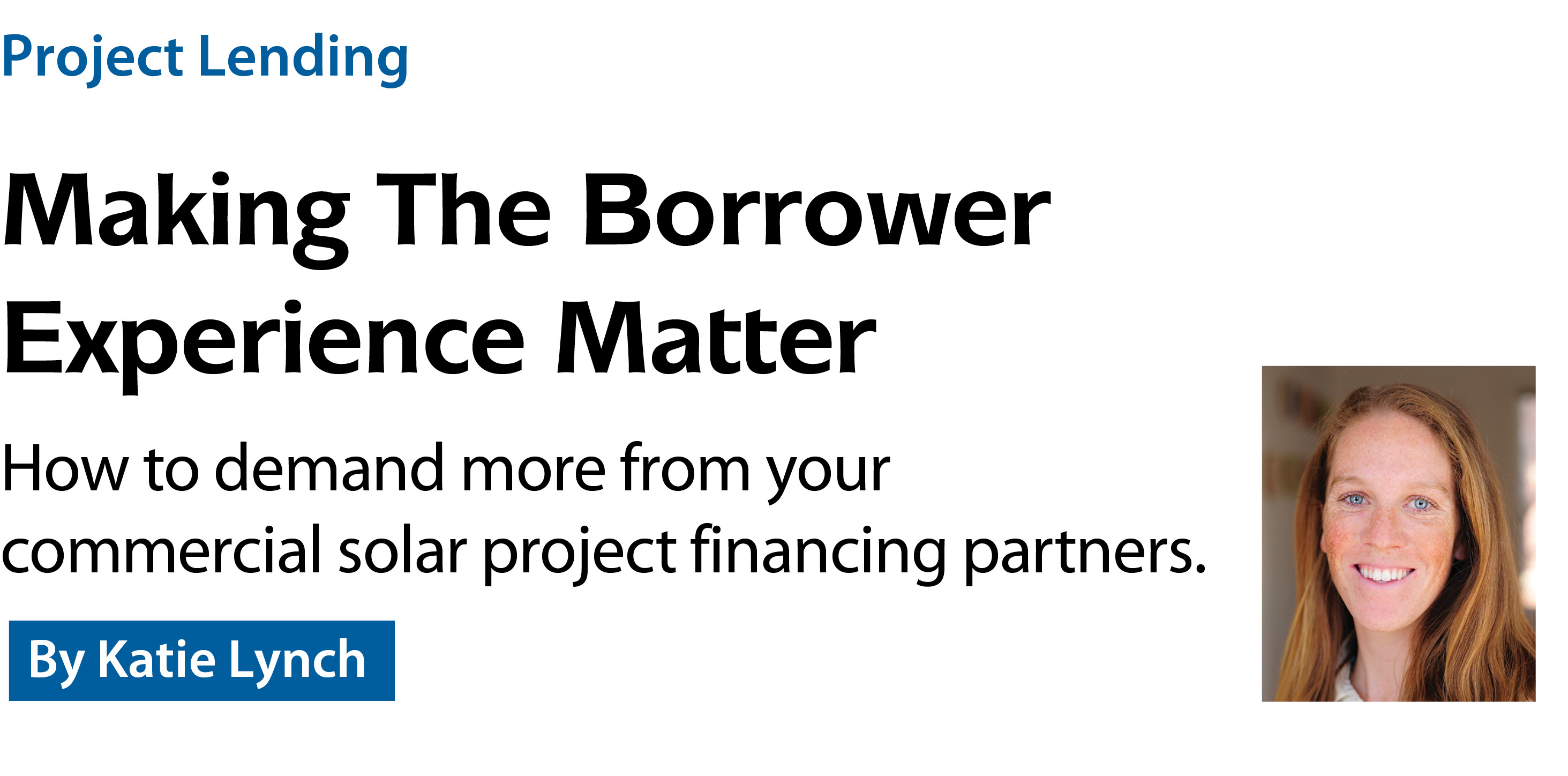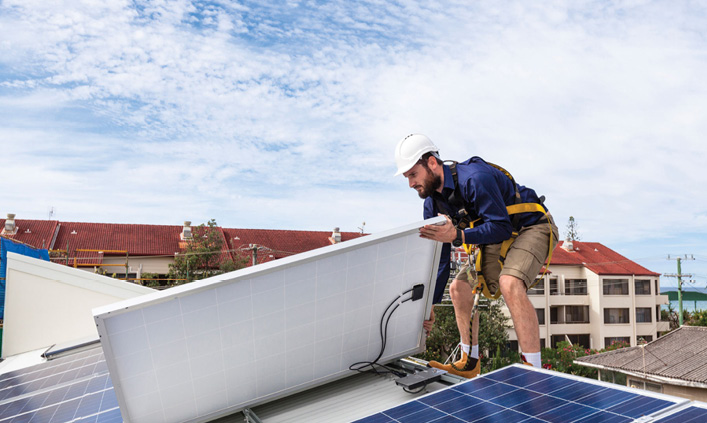

301 Moved Permanently
In the early days of solar, most systems were purchased in cash. Unlike with other large purchases, such as cars and houses, a well-developed financial services market for solar projects simply didn’t exist yet. In recent years, capital markets have recognized the size of financing demand that the solar industry presents and have been scrambling to find their place in the market. Lenders began by looking for ways to target solar financing opportunities that could fit into their existing loan products and lending philosophy. These projects were mostly residential and large commercial - two sectors whose rapid growth is at least partly attributed to an infusion of capital. However, as more and more investors enter the space, the balance of scales has begun to tip in favor of demand, resulting in an increased focus on differentiators such as customer experience and partnership benefits.
With mainstream attention being paid to high-profile rate policies, the federal investment tax credit extension and international environmental agreements, capital providers will continue to keep their eye out for new opportunities in the growing solar market. New lenders will almost certainly be entering into the oft-noted, but still underserved, small-to-midsize commercial market. Solar professionals should be aware of an increasing number of financing options in this sector, as well as of their purchasing power in this shifting dynamic.
Why it is the way it is
First, let’s take a step back and discuss some of the key tenants of the lending world in which we find ourselves. Traditional lenders (e.g., banks) have built most of their current loan products and lending philosophies on a tradition of conservatism, risk aversion and trend following. They need to feel a high degree of certainty when making financial decisions, and they need this certainty to come from substantial amounts of reliable data that help them quantify either 1) the risk of default or 2) recoverable value in the event of default - ideally, they feel confident about both.
The risk of default for many borrowers has already been calculated through standardized rating systems such as FICO scores for residential borrowers and S&P and Moody’s ratings for large commercial or utility borrowers. These credit ratings have allowed for many solar loans to be provided cost-effectively, contributing to huge growth at the residential and utility scale without lenders needing to take on the risk and cost associated with developing a new method of underwriting. The difficulty that unrated borrowers have in securing a loan is not specific to the solar industry. Small-business credit review has been a one-off and time-consuming process for everyone involved for a long time.
Secured loans, in which borrowers use their assets as collateral, can be helpful for those looking to borrow more than their credit rating and history would allow. This is because secured loans provide some certainty of recoverable loan value. Loans that are secured with measurable assets can generally be issued at lower interest rates and higher amounts, which is why an individual might have a $15,000 credit card maximum but have no problem securing a $400,000 home mortgage. Years and years of data have proven a fairly predictable value for certain assets, such as real estate and cars. When a lender knows that a default would still allow it to recover a significant amount, if not all, of the original loan value, default risk is less of a concern. However, while logic tells us that solar systems could be a strong, recoverable asset, the data is simply not there yet. This makes unrated projects - which account for a majority of the commercial space - very costly or impossible to finance. Lenders have to perform detailed, one-off project diligence - a process that is often burdened with data requirements and is generally not cost-effective for loan amounts less than $1 million.

Reinventing the wheel (sort of)
Over the past five to 10 years, financiers have been kept busy satisfying the demand for rated projects. But their success, as well as rapid industry growth, has drawn more capital to the industry and increased competition for rated projects. The commercial space is attracting notice as an obvious - and as-yet untapped - market opportunity. However, succeeding in this space is going to require a significant amount of innovation to the aforementioned traditional lending assumptions and practices. A lender that is going to be successful in the commercial solar space will have to take inspiration from components of both the residential and large-scale solar loan markets, as well as the emerging “fintech” industry.
A growing number of marketplace lending platforms have emerged in the last decade. A popular trend in the venture capital world, these companies are looking to take advantage of the traditionally slow-to-innovate and risk-averse banking industry by using software to create automated underwriting processes for specific loan types. Online applications that are integrated with databases and application program interfaces not only reduce the internal costs associated with servicing a loan, but also greatly improve the customer experience in the form of reduced data requirements and quicker turnaround times.
Finally, and perhaps most important to this discussion, a number of emerging financial technology companies are using crowdfunding as a way of freeing themselves from the restrictions that come with institutional capital. This allows them to redefine the lens through which certain loans and borrowers are evaluated - including students, real estate, small businesses and, you guessed it, solar projects.
Alongside, and in many ways a part of, this financial technology trend has been an evolving solar loan market. On the residential side, the amount of institutional capital backing solar loan providers has increased dramatically, with the landscape of options displaying a widening range of players and financial products. Some financiers have developed partnership programs, allowing them to rely on engineering, procurement and construction contractors for regional expertise and project origination, development and installation. Solar customers have experienced improvements in the quality of product explanation that installers are able to provide, as well as increased transparency through online quote and comparison tools, which help to drive down costs and reduce research time. Installers that have dedicated financing partners have been able to reduce time and coordination costs to the extent that the financing process now rarely holds up a project.
In large-scale project finance, there has been slightly less focus on creating convenience and borrower efficiencies and a great deal of attention paid to evaluating solar as an asset. More and more solar-specific investors have emerged, each with its own diligence models and portfolios of system performance data. As these assets age, system and borrower behavior will be an important factor in converging on a trusted and consistent project diligence process. However, while gathering large amounts of pre-loan and post-installation data is very important to the goal of eventually convincing more conservative lenders of the asset value of solar, it is currently coming at great expenses, both resource and time, to borrowers and lenders alike.
A lender that wants to break into the small-to-midsize commercial solar space is going to have to find a way to combine the best of all of these examples to create a borrower process that is able to handle the nuances of commercial deals and understand the value of the project itself while keeping internal transaction costs down through significant automation and selective data requirements.
A tall order? You bet. Do-able? Definitely.
What you care about most
As the project originator, the most important thing you can do to make sure that you and your business are being served is to ensure that improvements to borrower experience are not lost in the shuffle. Unlike in the residential market, many project originators and installers have resigned themselves to far lower expectations for the commercial project finance process. Given that lenders looking to break into this space will be focused on reducing their own transaction costs and measuring risk, they may be tempted to keep your customer experience expectations low - especially because easy ways for them to reduce internal costs include putting more of the diligence burden on the borrower through detailed application processes and extensive data requirements.
As you begin to see more financiers offering loan products for unrated projects, don’t discount the cost of your time when considering a new option. As competition among lenders in the space increases, so too will it among installers and developers. Look for financiers that are earning your partnership by adding value to your sales process, not burdening it with additional data collection and legal costs. Ask the right questions to set the right expectations for what you are looking for: What is the average turnaround time on an application? How long are the contracts? What type of collateral is necessary? What are the prepayment policies? Can customers pay online? Will a project be considered before it is under contract?
It may be a while yet before the commercial loan market reaches the level of efficiency and speed present in the residential market, but that should still be the goal.
Project Lending
Making The Borrower Experience Matter
By Katie Lynch
How to demand more from your commercial solar project financing partners.
si body si body i si body bi si body b
si depbio
- si bullets
si sh
si subhead
pullquote
si first graph
si sh no rule
si last graph